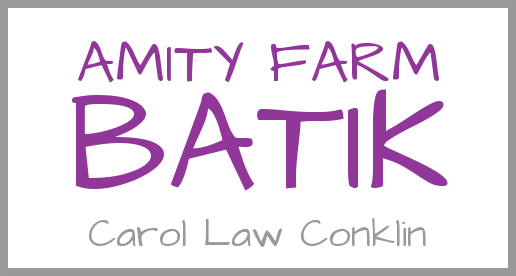The mixing of dye is time consuming for me and I am careful to add what needs to be added, (casolene oil, urea, water softener and more) to help the dyes to be vibrant and mesh well with the cloth. I also strain the mix through an old cloth so there won’t be any “flecks” of dye that did not mix well.
Dyeing is not so bad though. I actually love to dye fabric. Back to basics of fabric. Before any artwork is done on cloth it must be scoured with detergent in hot water to remove any sizing and shrink it. Natural cotton is the fabric I use for most my batik but I also paint on silk, a more delicate fabric. After the first stage design has been painted or applied with a tjanting I wet the fabric before immersing in the dye bath. Once in the dye bath the fabric needs to be gently moved ( gently so as to not damage the wax). See my last post for information on mixing dye. The temperature for batik is slightly warm for best absorption of color without melting the wax. Cold water may be used, but the colors won’t be as bright and it will need to be in the dye bath much longer. The color should be checked when stirring and realize the color will appear much lighter when dry.
Soda ash must be added to the dye bath to activate the dye. A formula for 1 pound of fabric is;
3 gallons of warm water, 1 tablespoon dye, for more intense colors, 2 tablespoons dye and 3 to 4 tablespoons for very dark colors such as black and navy. Plain salt is added at 3 cups and increased with darker shades. 1/3 cup of soda ash is also added and 2 teaspoons of calsolene oil makes for better dissolving of dye. Once the soda ash is added, the life of the dye is limited by a few hours, so be sure to be ready to dye! For light colors the fabric can stay immersed for 20 minutes to half an hour. A dark shade would benefit from an hour or more in the dye bath. A large piece of fabric or several pieces can be dyed in the washing machine, just keep control so as to not have the dye spun out prematurely.
When the color has reached a darker shade than you feel you want, it is time to rinse out the excess dye. I like to rinse in an old sink outdoors (see photos of my Flower sink and the day lillies to go with it!)I also like to dye fabric in the warm months outdoors so I can spill and not have a speckled home. Rinse, rinse and rinse. Then let dry. the cloth may lie flat or hang on a line ( some separating of color can occur while hanging so be careful). For dark colors a slower drying helps to keep the color brilliant. Put the fabric in plastic for a very slow dry. When dry apply the next stage of wax with brush or tjanting to the areas you want to remain the newly dyed color, and repeat the process.
An alternative process to adding soda ash to the dye is to leave it out of the dye bath but soak the fabric in a soda ash mix, let drain an then immerse in the dye bath. This method allows the mixed dye a longer life. Urea added also increases the life of dye. You should be able to dye many smaller pieces over about a week, instead of all at once.
An alternative process to adding soda ash to the dye is to leave it out of the dye bath but soak the fabric in a soda ash mix, let drain an then immerse in the dye bath. This method allows the mixed dye a longer life. Urea added also increases the life of dye. You should be able to dye many smaller pieces over about a week, instead of all at once.
I use small and large tubs to dye in and have a long flat plastic container for large pieces that I don’t wish to have crumpled, which could result in excess crackling of the wax. Most my summer work is quite large in size, taking advantage of the space in the great outdoors. In the winter I work on smaller pieces as well as scarves and purses that only need small tubs to be dyed.
My supply sources are http://www.dharmatradingcompany.com/ in San Rafael, California,which has a tremendous selection of dyeing supplies and fabric as well as good directions in their catalog. Also http://www.prochemical.com/ , Somerset, Massachusetts also a large selection of dyeing supplies. They also sponsor some excellent workshops. workshops@prochemical.com. Both have good technical advice available.
See the photos to see me dyeing some of my large pieces. Always be aware of the translucent nature of dye. Each color is affected by the previous colors. The images pictured are in the middle stages of completion. I will have more on the batik process in future posts. Meanwhile I hope this imformation helps. Happy Dyeing!

Trackbacks/Pingbacks